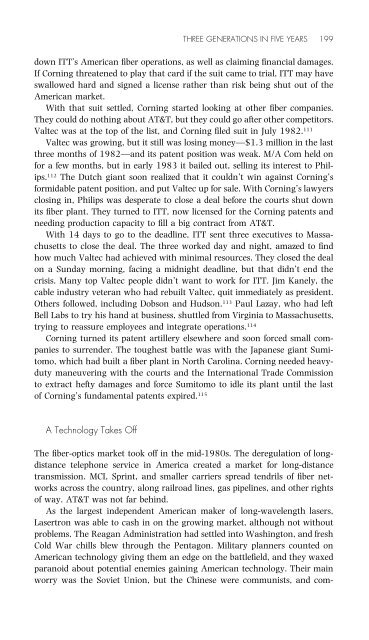City of Light: The Story of Fiber Optics
City of Light: The Story of Fiber Optics
City of Light: The Story of Fiber Optics
Create successful ePaper yourself
Turn your PDF publications into a flip-book with our unique Google optimized e-Paper software.
THREE GENERATIONS IN FIVE YEARS 199<br />
down ITT’s American fiber operations, as well as claiming financial damages.<br />
If Corning threatened to play that card if the suit came to trial, ITT may have<br />
swallowed hard and signed a license rather than risk being shut out <strong>of</strong> the<br />
American market.<br />
With that suit settled, Corning started looking at other fiber companies.<br />
<strong>The</strong>y could do nothing about AT&T, but they could go after other competitors.<br />
Valtec was at the top <strong>of</strong> the list, and Corning filed suit in July 1982. 111<br />
Valtec was growing, but it still was losing money—$1.3 million in the last<br />
three months <strong>of</strong> 1982—and its patent position was weak. M/A Com held on<br />
for a few months, but in early 1983 it bailed out, selling its interest to Philips.<br />
112 <strong>The</strong> Dutch giant soon realized that it couldn’t win against Corning’s<br />
formidable patent position, and put Valtec up for sale. With Corning’s lawyers<br />
closing in, Philips was desperate to close a deal before the courts shut down<br />
its fiber plant. <strong>The</strong>y turned to ITT, now licensed for the Corning patents and<br />
needing production capacity to fill a big contract from AT&T.<br />
With 14 days to go to the deadline, ITT sent three executives to Massachusetts<br />
to close the deal. <strong>The</strong> three worked day and night, amazed to find<br />
how much Valtec had achieved with minimal resources. <strong>The</strong>y closed the deal<br />
on a Sunday morning, facing a midnight deadline, but that didn’t end the<br />
crisis. Many top Valtec people didn’t want to work for ITT. Jim Kanely, the<br />
cable industry veteran who had rebuilt Valtec, quit immediately as president.<br />
Others followed, including Dobson and Hudson. 113 Paul Lazay, who had left<br />
Bell Labs to try his hand at business, shuttled from Virginia to Massachusetts,<br />
trying to reassure employees and integrate operations. 114<br />
Corning turned its patent artillery elsewhere and soon forced small companies<br />
to surrender. <strong>The</strong> toughest battle was with the Japanese giant Sumitomo,<br />
which had built a fiber plant in North Carolina. Corning needed heavyduty<br />
maneuvering with the courts and the International Trade Commission<br />
to extract hefty damages and force Sumitomo to idle its plant until the last<br />
<strong>of</strong> Corning’s fundamental patents expired. 115<br />
A Technology Takes Off<br />
<strong>The</strong> fiber-optics market took <strong>of</strong>f in the mid-1980s. <strong>The</strong> deregulation <strong>of</strong> longdistance<br />
telephone service in America created a market for long-distance<br />
transmission. MCI, Sprint, and smaller carriers spread tendrils <strong>of</strong> fiber networks<br />
across the country, along railroad lines, gas pipelines, and other rights<br />
<strong>of</strong> way. AT&T was not far behind.<br />
As the largest independent American maker <strong>of</strong> long-wavelength lasers,<br />
Lasertron was able to cash in on the growing market, although not without<br />
problems. <strong>The</strong> Reagan Administration had settled into Washington, and fresh<br />
Cold War chills blew through the Pentagon. Military planners counted on<br />
American technology giving them an edge on the battlefield, and they waxed<br />
paranoid about potential enemies gaining American technology. <strong>The</strong>ir main<br />
worry was the Soviet Union, but the Chinese were communists, and com-

















